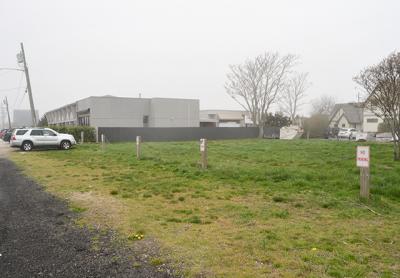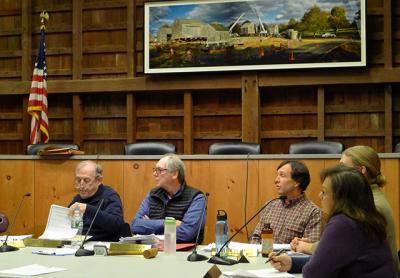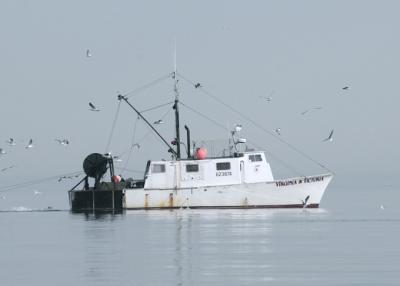Montauk Beach House Pitches a Party Tent
Montauk Beach House Pitches a Party Tent

The East Hampton Town Planning Board wrestled with two Montauk applications on April 26. Members also learned that an objectionable gate installed by Steven A. Cohen, the hedge fund manager whose Point72 Asset Management company has an office in the former Wei Fun restaurant on Pantigo Road in East Hampton, had been scrapped.
One of the Montauk applications is from the Beach House Resort on the southeast portion of Carl Fisher Plaza. The owner, Larry Siedlick, recently purchased an adjoining vacant 12,000-square-foot parcel on South Elmwood Avenue, and wants to use it for a 3,200-square-foot tent.
“It seems that the Montauk Beach House would utilize this property for special events most weekends during the summer season,” Eric Schantz, a planner for the town, said in a memo. He based this on conversations he had with the applicant’s agent, Susan Brierley of Due East Planning, but during the discussion it was unclear exactly when the tent would be used.
“I am confused,” Nancy Keeshan, a board member, said, apparently speaking for several others. Job Potter, the board chairman, asked what the tent would be used for. “Our client would like to use it in conjunction with the Beach House, exclusively for the Beach House,” was the answer.
The site plan proposed calls for parking and electricity to be added to the property, but Mr. Potter asked, “Why go through all that?” Ian Calder-Piedmonte, another board member, followed up with a more basic question. “Would we even be allowed to approve a parking lot on a site without a primary use?”
Parking was a major concern for Mr. Schantz, who wrote that there did not appear to be any plan to fold the new property into the Beach House site, meaning the owners could not claim the tent as an accessory use. While the Beach House, in downtown Montauk, is zoned for resort use, it is nonconforming because it has no on-site parking.
In the end, board members and John Jilnicki, the board’s attorney, agreed the applicant should take a different approach and send a letter to the Town Board, explaining the use of the tent, to see if it qualifies for a mass-gathering permit.
The other Montauk application received a skeptical response. It came from Gone Fishin’ Marina, which wants to increase seating for its restaurant on the marina site, which is toward the end of East Lake Drive, from 16 to 54. Most of the additional seats would be at tables on an outdoor deck.
The property was approved in 1992 as a multiple business complex, with two retail stores, a boat storage and repair barn, and a 177-slip marina. The issue now before the board, JoAnne Pahwul, the town’s assistant planning director; said, is the calculation of how many seats could be added under the town code, saying that outdoor dining was not to exceed 30 percent of the permitted enclosed use. In 2012, the Town Building Department found that 30 percent was to be based on the capacity of the interior of the restaurant. In this case, that number is 16, so the restaurant would be allowed an additional 4.8 seats.
Joel Halsey, representing the marina, argued for a different method of calculating outdoor seating. In his view, it should be based on the interior space on the entire Gone Fishin’ property, not just the restaurant. Mr. Halsey, a former town Planning Department staff member, did not agree with Marguerite Wolffsohn, who is the head of that department, who told the board that “enclosed use” refers only to interior restaurant space.
“It doesn’t make sense,” Mr. Halsey countered. He said that under that logic, the town would be encouraging owners to build bigger restaurants. “I’ve got 16 enclosed seats. Let me knock down some walls here,” he said.
Kathleen Cunningham, a board member, said her main concern was Lake Montauk, which the restaurant faces, calling the lake a “challenged body.” Mr. Potter agreed. “This is very close to Lake Montauk. Any increased use has to be looked at very carefully,” he said.
Questions about parking, the sanitary system, and whether there is an apartment at the site remained open. Mr. Halsey said he might seek a determination from the town’s head building inspector on the 30 percent calculation.
As for Mr. Cohen, his architect last year, Alexander Baranovich, ran afoul of the board when a sliding entrance gate with cedar facing was installed without site plan approval. Mr. Baranovich explained to the planning board in February 2016 that gates were needed in front and back of the property because drivers and pedestrians were cutting through the lot to access an alley and neighboring businesses, such as Goldberg’s Famous Bagels.
Board members were unhappy last year not only that the elaborate front gate was installed without permission but that it was out of character with the area and had a “gated community” look, along with a chain-link fence with a keyed entry at the rear of the property. It soon vanished.
With a new architect now in charge of the design, the board learned on April 26 that a new method of closing off the area was planned. Instead of last year’s unfriendly gate, this year industrial bollards are to be set in the ground that will rise up at Mr. Cohen’s and his employees’ command, blocking access to the front of the property, while being visually open.
“I like it. I think you did a good job,” Ms. Keeshan said, a sentiment that was embraced by the other board members. Mr. Cohen’s bollards will next go to the town’s architectural review board for approval.



